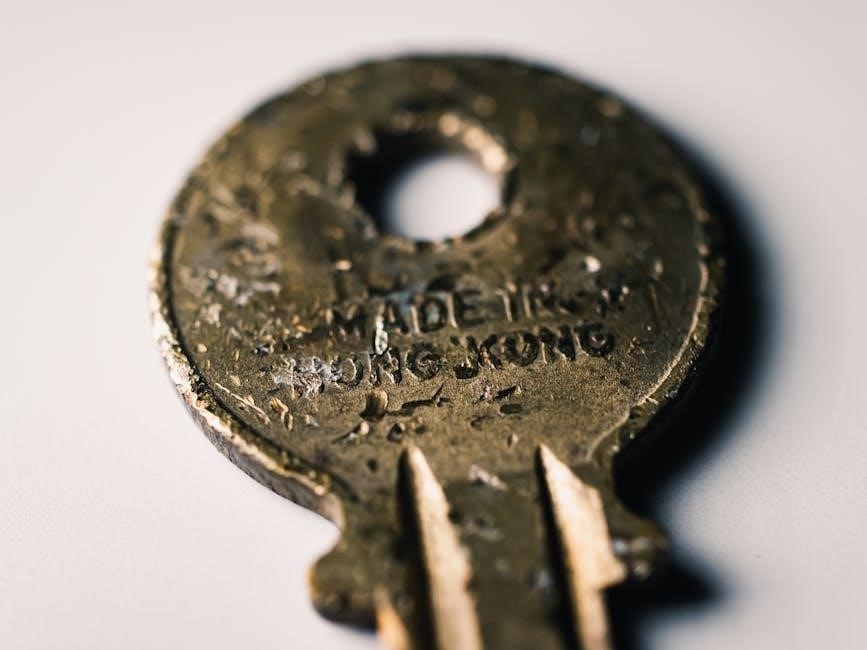The cell cycle is a series of stages cells undergo to grow and divide. It includes interphase and mitosis‚ ensuring DNA replication and cell division. Understanding the cell cycle is crucial for studying cellular growth‚ repair‚ and reproduction. Educational resources like worksheets and answer keys provide detailed diagrams and labeling activities to help students master this concept.
1.1 Overview of the Cell Cycle
The cell cycle is a highly organized process by which cells grow‚ replicate their DNA‚ and divide into two daughter cells. It consists of two main phases: interphase and the mitotic phase. During interphase‚ the cell grows‚ replicates its DNA‚ and prepares for cell division. The mitotic phase includes mitosis and cytokinesis‚ where the replicated DNA and cellular components are divided equally between two new cells. Understanding the cell cycle is fundamental in biology‚ as it underpins cellular growth‚ tissue repair‚ and reproduction. Resources like labeling worksheets and answer keys provide visual and interactive tools to help students grasp this complex process.
1.2 Importance of the Cell Cycle in Biology
The cell cycle is a cornerstone of biology‚ essential for understanding cellular growth‚ DNA replication‚ and tissue repair. It ensures genetic continuity by replicating DNA and dividing cells evenly‚ maintaining organismal health. Studying the cell cycle helps explain cancer development‚ where uncontrolled cell division occurs. Educational tools like labeling worksheets and answer keys provide interactive ways to learn about the cell cycle‚ making it accessible for students to grasp its significance in biology and its role in life processes.

Phases of the Cell Cycle
The cell cycle consists of G1‚ S‚ G2‚ and M phases‚ each with distinct functions in cell growth and division. The M phase includes mitosis and cytokinesis.
2.1 G1 Phase
The G1 phase is the first gap phase of the cell cycle‚ where the cell grows‚ prepares for DNA replication‚ and performs normal cellular functions. During this phase‚ the cell increases in size‚ produces essential enzymes‚ and replicates organelles. It also checks for DNA damage and ensures readiness for DNA synthesis. The G1 phase is critical for cell growth and preparation for the S phase‚ where DNA replication occurs. This phase ensures that the cell is ready to proceed with the cell cycle by storing energy and producing necessary proteins. Proper functioning of the G1 phase is essential for maintaining genomic stability.
2.2 S Phase
The S phase is the synthesis phase of the cell cycle‚ during which DNA replication occurs. Each chromosome is replicated‚ forming two identical sister chromatids joined at the centromere. This phase ensures that the genetic material is duplicated accurately before cell division. Enzymes like DNA polymerase play a key role in replicating DNA‚ while repair mechanisms correct any errors. The S phase is crucial for maintaining genetic integrity and ensuring that daughter cells receive identical DNA. Proper DNA replication in this phase is essential for normal cell function and division‚ preventing genetic abnormalities in the resulting cells.
2.3 G2 Phase
The G2 phase is the second gap phase of the cell cycle‚ following DNA replication in the S phase. During this phase‚ the cell prepares for mitosis by producing essential proteins‚ organelles‚ and enzymes; It also performs a final check for DNA damage‚ repairing any errors before entering mitosis. This phase ensures that the cell is ready for division and that all necessary components are in place. The G2 phase acts as a critical checkpoint‚ verifying the integrity of DNA and ensuring proper cell division. Its proper functioning is vital for maintaining cellular health and preventing errors during mitosis.
2.4 M Phase
The M phase‚ or mitotic phase‚ is the most visually dramatic stage of the cell cycle‚ consisting of mitosis and cytokinesis. During mitosis‚ the replicated DNA condenses into chromosomes‚ which are aligned‚ separated‚ and distributed equally to two daughter cells. Cytokinesis then divides the cytoplasm and organelles‚ completing the cell division. This phase ensures genetic continuity and maintains the species’ chromosome number. Proper execution of the M phase is critical for growth‚ repair‚ and reproduction. Worksheets and answer keys often include diagrams labeling mitotic stages‚ aiding students in understanding this complex process.
Key Structures Involved in the Cell Cycle
Key structures in the cell cycle include centrioles‚ spindle fibers‚ chromatids‚ and the cell plate. Centrioles organize spindle fibers‚ which align chromatids during mitosis. The cell plate forms in plant cell cytokinesis.
3.1 Centrioles
Centrioles are small‚ cylindrical organelles near the nucleus. They play a crucial role in organizing spindle fibers during mitosis. Each centriole consists of nine triplets of microtubules. During interphase‚ centrioles replicate‚ ensuring two pairs for cell division. In mitosis‚ they migrate to opposite poles‚ forming spindle fibers that align chromatids. This ensures proper chromosome separation. Centrioles are labeled in diagrams to highlight their function in cell division. Their structure and role are essential for understanding mitosis mechanics‚ making them a key focus in cell cycle labeling activities and educational resources. Their accurate identification is vital for students studying cellular biology.
3.2 Spindle Fibers
Spindle fibers are dynamic structures composed of microtubules that form during mitosis. They originate from centrioles and extend across the cell‚ playing a key role in chromosome alignment. During prophase‚ spindle fibers attach to centromeres‚ ensuring chromatids are properly aligned at the metaphase plate. In anaphase‚ they pull sister chromatids apart‚ ensuring each daughter cell receives identical genetic material; Spindle fibers are crucial for maintaining genetic integrity during cell division. Their correct labeling in diagrams is essential for understanding mitosis‚ making them a focal point in cell cycle labeling activities and educational resources. Their dynamic nature ensures precise chromosome segregation‚ vital for cellular continuity.
3.3 Chromatids
Chromatids are identical DNA molecules joined at the centromere‚ forming a chromosome’s structure. During the S phase of interphase‚ DNA replicates‚ creating two chromatids. In prophase‚ they condense and become visible. Spindle fibers attach to centromeres‚ aligning chromatids at the metaphase plate. In anaphase‚ sister chromatids separate‚ moving to opposite poles. This ensures each daughter cell receives identical genetic material. Correctly labeling chromatids in cell cycle diagrams is crucial for understanding mitosis. Educational resources often emphasize chromatid identification‚ making them a key focus in cell cycle labeling activities and studies. Their role in DNA distribution highlights their importance in cellular reproduction and genetic continuity.
3.4 Cell Plate
The cell plate is a temporary structure that forms during telophase in plant cells‚ marking the site of cell wall formation. It develops from vesicles in the center of the cell‚ gradually expanding outward. The cell plate ensures proper separation of the cytoplasm and organelles into two daughter cells. This process is unique to plant cells‚ as animal cells undergo cytokinesis through cleavage. Labeling the cell plate in diagrams helps students understand its role in plant cell division. Educational resources often highlight the cell plate in worksheets to emphasize its importance in plant cell cytokinesis and overall cellular structure. It is a critical component for maintaining genetic continuity in plant cells.

Importance of Mitosis
Mitosis is essential for cellular growth‚ tissue repair‚ and maintaining genetic continuity. It ensures accurate DNA replication and equal distribution of chromosomes to daughter cells‚ supporting life and development.
4.1 Role in Cellular Growth
Mitosis plays a critical role in cellular growth by enabling cells to increase in number and size. During mitosis‚ a parent cell divides into two genetically identical daughter cells‚ ensuring proper distribution of organelles and resources. This process is essential for tissue expansion‚ organ development‚ and maintaining the body’s cellular architecture. Educational tools‚ such as cell cycle labeling worksheets‚ help students visualize and understand how mitosis contributes to growth and development. These resources often include diagrams and answer keys to reinforce learning outcomes.
4.2 Role in DNA Replication
Mitosis ensures accurate DNA replication‚ a critical process during the S phase of the cell cycle. Each chromosome duplicates‚ forming two identical sister chromatids. During mitosis‚ these chromatids are evenly distributed to daughter cells‚ ensuring genetic continuity. This precise replication and distribution are vital for maintaining cellular function and genetic stability. Educational resources‚ such as cell cycle labeling worksheets‚ often include diagrams and answer keys to help students track DNA replication and its relationship to mitosis‚ reinforcing the understanding of this fundamental biological process.
4.3 Role in Tissue Repair
Mitosis plays a vital role in tissue repair by enabling the replacement of damaged or dead cells. When tissues are injured‚ mitotic activity increases to produce new cells‚ restoring tissue integrity. This process is essential for healing wounds‚ regenerating skin‚ and maintaining organ function. Educational resources‚ such as cell cycle labeling worksheets‚ often highlight this role‚ helping students understand how mitosis contributes to tissue regeneration and overall health. These tools emphasize the importance of mitosis in sustaining cellular vitality and supporting the body’s repair mechanisms‚ making them invaluable for biology education.

Cell Cycle Diagram
A cell cycle diagram illustrates the stages of cell division‚ from interphase to mitosis. It helps visualize chromosome behavior‚ nuclear changes‚ and cytokinesis‚ aiding in labeling activities for educational purposes.
5.1 Labeling the Phases
Labeling the phases of the cell cycle involves identifying and naming each stage based on specific cellular characteristics. Interphase‚ the longest phase‚ shows no visible changes under a microscope‚ while prophase is marked by chromatin condensation. Metaphase features chromosomes aligned at the center‚ anaphase involves chromatids being pulled apart‚ and telophase sees the reformation of nuclei. Accurate labeling requires understanding these distinct features. Educational resources‚ such as PDF worksheets and answer keys‚ often include diagrams with labeled phases to help students master this process. These tools emphasize the importance of precise identification for a clear understanding of cellular division.
5.2 Labeling the Structures
Labeling the structures involved in the cell cycle is essential for understanding their roles in cellular division. Key structures include centrioles‚ spindle fibers‚ chromatids‚ and the cell plate. Centrioles are near the nucleus and help organize spindle fibers‚ which guide chromosome movement. Chromatids are identical DNA strands that separate during anaphase. The cell plate forms during cytokinesis in plant cells. Educational resources like PDF worksheets and answer keys provide detailed diagrams and labeling exercises to help students accurately identify these structures. These tools ensure a clear understanding of how each component functions within the cell cycle process.

Step-by-Step Explanation of the Cell Cycle
Interphase: Cell grows‚ DNA replicates. Mitosis: Prophase (chromatin condenses)‚ metaphase (chromosomes align)‚ anaphase (separate)‚ telophase (nucleus reforms). Cytokinesis: Cytoplasm divides‚ cell splits.
6.1 Preparing for DNA Replication
During the G1 phase‚ the cell prepares for DNA replication by increasing in size and replicating organelles. Proteins and enzymes necessary for replication are synthesized. The cell accumulates nutrients and energy reserves. DNA replication occurs in the S phase‚ but proper preparation in G1 ensures accuracy. Checkpoints in G1 verify cell readiness‚ preventing damaged or stressed cells from proceeding. This phase is critical for maintaining genetic integrity and ensuring proper cell function. Educational resources‚ like worksheets and answer keys‚ often highlight this phase’s importance in DNA replication and cell cycle progression.
6.2 DNA Replication Process
DNA replication occurs during the S phase of the cell cycle‚ ensuring genetic material is duplicated accurately. The process begins with helicase unwinding DNA‚ forming replication forks. DNA polymerase then adds nucleotides to template strands‚ synthesizing new complementary strands. This results in two identical sister chromatids. Checkpoints ensure errors are corrected to maintain genomic stability. Proper replication is vital for cell function and inheritance. Educational resources‚ such as worksheets and answer keys‚ often detail this process‚ emphasizing its importance in cellular reproduction and prevention of mutations that could lead to conditions like cancer.
6.3 Preparing for Cell Division
During the G2 phase‚ the cell prepares for division by producing organelles and proteins essential for mitosis. This includes assembling spindle fibers and centrioles‚ which guide chromosome separation. The cell also synthesizes enzymes for DNA repair and energy storage. Proper preparation ensures mitosis proceeds accurately. Educational materials‚ such as cell cycle labeling answer keys‚ highlight these steps‚ emphasizing their role in maintaining cellular integrity and genetic continuity. This phase is critical for preventing errors during cell division‚ ensuring daughter cells receive identical genetic material.
6.4 Cell Division Process
Mitosis and cytokinesis are the final stages of the cell cycle‚ ensuring the creation of two genetically identical daughter cells. Mitosis consists of prophase‚ metaphase‚ anaphase‚ and telophase. During prophase‚ chromatin condenses into chromosomes‚ and the spindle fibers form. In metaphase‚ chromosomes align at the cell’s center. Anaphase sees sister chromatids separating‚ while telophase reverses prophase changes. Cytokinesis then divides the cytoplasm‚ forming two cells. These processes are detailed in cell cycle labeling answer keys‚ helping students identify and understand each step. Proper labeling of structures like spindle fibers and chromatids is essential for mastering this critical phase.
Resources and Answer Keys
Free PDF worksheets and answer keys are available online‚ offering detailed diagrams and labeling activities. These resources help students and educators understand the cell cycle phases and structures‚ ensuring accurate identification and learning. Interactive tools and guides complement traditional materials‚ providing comprehensive support for biology education.
7.1 Free PDF Worksheets
Free PDF worksheets on the cell cycle are widely available online‚ offering comprehensive learning tools. These worksheets include diagrams of cells in various phases‚ such as interphase‚ prophase‚ metaphase‚ anaphase‚ and telophase. Students are tasked with labeling structures like centrioles‚ spindle fibers‚ and chromatids. Answer keys are provided to ensure accurate learning. Many worksheets also feature fill-in-the-blank questions and matching exercises to reinforce key concepts. These resources are ideal for classroom use or self-study‚ making complex biological processes accessible and engaging for learners of all levels. They are easily downloadable and printable for convenient use.
7.2 Online Interactive Tools
Online interactive tools provide dynamic learning experiences for understanding the cell cycle. Platforms like HHMI BioInteractive offer Click and Learn simulations‚ enabling students to explore the cell cycle phases interactively. These tools include virtual labs‚ quizzes‚ and real-time feedback. Interactive diagrams allow learners to label structures like centrioles and spindle fibers‚ enhancing retention; Many tools are web-based‚ accessible via browsers‚ and suitable for classrooms or self-study. They complement traditional worksheets by offering engaging‚ hands-on experiences. These resources are particularly useful for visual learners‚ providing a deeper understanding of cellular processes and their importance in biology.
7.3 Biology Corner Answer Key
Biology Corner provides a comprehensive answer key for cell cycle labeling worksheets. This resource includes detailed explanations for identifying phases like interphase‚ prophase‚ and metaphase. It also covers structures such as centrioles and spindle fibers. The answer key aligns with educational standards‚ ensuring accuracy and clarity. Educators and students can access printable PDF versions‚ making it ideal for classroom use. The key emphasizes understanding the sequence of cellular events and their significance. By using this resource‚ learners can verify their work and gain confidence in their knowledge of the cell cycle and its processes.